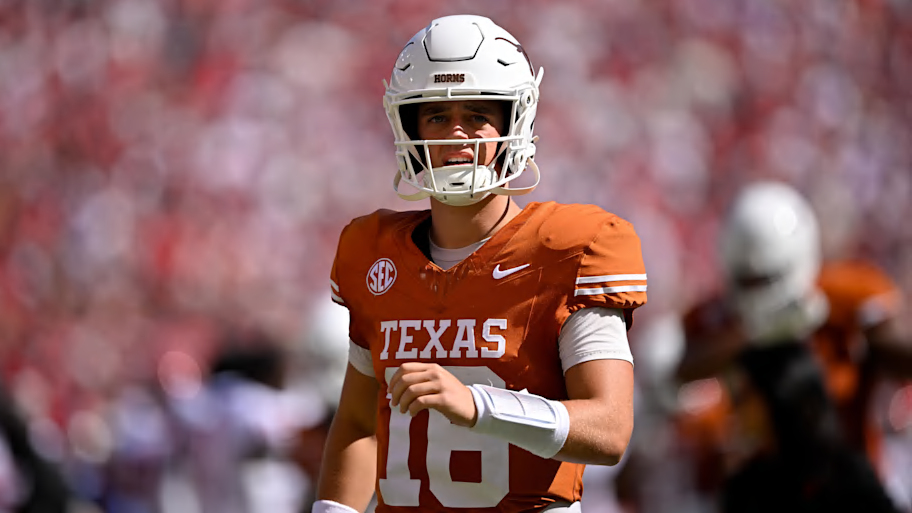The first half of the college football season has turned just about everything we thought we knew about the sport on its head. Sure, Ohio State is still in the heat of the College Football Playoff discussion, but Miami, Indiana and Texas Tech were not widely expected to be on a similar level. It looked like Kalen DeBoer's days were numbered after Week 1—now the Crimson Tide are in the national title mix. Penn State was a preseason championship favorite, and now James Franklin is updating his résumé.
Our expectations for some of the sport’s biggest stars have been reset after seven full weeks of football as well. Many of the preseason Heisman Trophy favorites—quarterbacks like Arch Manning, Cade Klubnik and Garrett Nussmeier—have struggled to live up to the preseason hype foisted upon them during the summer. Other elite skill position players looked set to make a huge impact on the national stage after transferring to new programs, only to find themselves down the depth chart.
Through the first half of the college football season, these 12 players have gotten off to particularly disappointing starts in 2025:
Nic Anderson, LSU WR
Oklahoma fielded one of college football's most dynamic offenses in 2023, with Dillon Gabriel throwing the ball around the yard to Drake Stoops, Jalil Farooq and Nic Anderson, then a redshirt freshman who would go on to lead the team with an impressive 21 yards per reception and tied for the lead with 10 touchdowns.
Injuries derailed the Oklahoma offense in 2024, few bigger than the quadriceps issue that limited Anderson to one appearance. He did not catch a pass last season, and transferred to LSU for 2025. While he had a few injury concerns in the offseason, Anderson has suited up in every game this season, but has not exceeded three receptions or 28 yards in any one outing. He made an impressive circus touchdown catch in LSU’s sole loss, a 24–19 defeat to Ole Miss, but was limited to just one catch for two yards in the Tigers’ following game, a win over South Carolina, even with star receiver Aaron Anderson out.
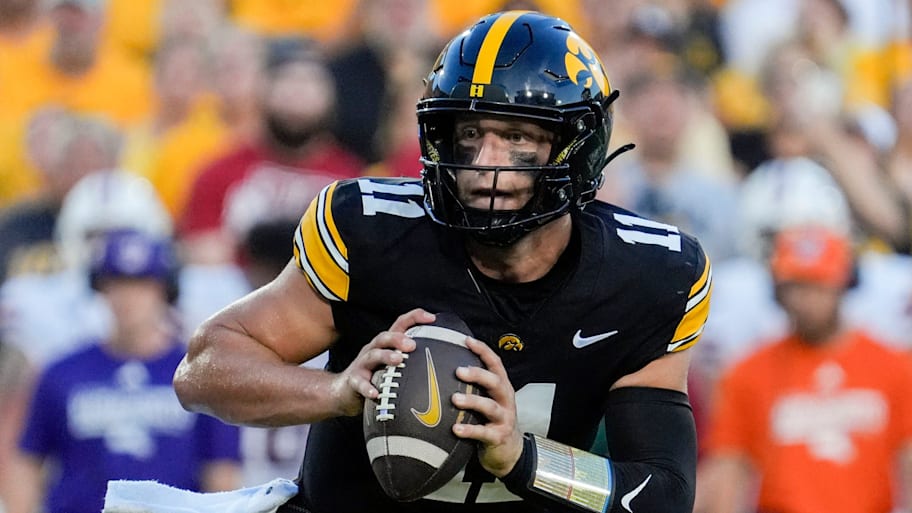
Mark Gronowski, Iowa QB
A legend at FCS program South Dakota State, Mark Gronowski seemed prime to be Iowa’s best quarterback in years, and to elevate an offense that has been stuck in the mud. Instead, Gronowski’s production looks much more like the Hawkeye quarterbacks of the last few seasons. He has not eclipsed 186 passing yards in any game, and he hasn’t thrown for a touchdown since a Week 3 win over UMass.
The jump from the Missouri Valley to the Big Ten is certainly a large one, but Gronowski threw for at least 2,700 yards in each of his three seasons starting for the Jackrabbits, and averaged 26 touchdown passes per year. He averaged over eight yards per attempt in each of those three seasons, and a robust 9.9 yards per attempt in 2023, when he took home the Walter Payton Award, the FCS equivalent of the Heisman. This year, that number has plummeted to 5.7. He’s rushed for a touchdown in every game thus far, including three in a 10-point win over Rutgers, but the passing efficiency is far below what people expected when Gronowski made his way to Iowa City.
Makhi Hughes, Oregon RB
Oregon’s addition of Makhi Hughes, a transfer running back from Tulane, seemed like an absolute home run. Hughes was one of the most dominant Group of 5 running backs not named Ashton Jeanty over the last two seasons, rushing for 1,378 yards and seven touchdowns as a redshirt freshman in 2023 and following it up with a 1,401-yard, 15-touchdown season in ’24.
On paper, Hughes looked like the perfect backfield pairing for new starting quarterback Dante Moore in Eugene, Ore. Instead, he saw just 19 touches on 42 snaps through the first four games of Oregon's season. His 17 carries were third among Ducks running backs during that run, and he got just one carry in each of the program’s wins over Montana State and Northwestern. Hughes opted to take a redshirt and sit out for the rest of the season, preserving his eligibility after playing in just four games, a strong indication that he’ll transfer again once the portal opens.
Avery Johnson, Kansas State QB
Kansas State entered the season as an expected Big 12 title contender, coming off of three consecutive nine-plus win seasons under Chris Klieman. This year marked the second full season with Avery Johnson as starting quarterback, and the dynamic dual-threat passer entered the year at 40–1 odds to win the Heisman—not a favorite but certainly someone on the radar.
As KSU has limped to a 3–4 start after entering the season ranked No. 17 in the country, Johnson hasn’t been the Wildcats’ biggest problem, but he doesn’t look like the same dynamic player that people expected for his second full season under center. Johnson’s completion percentage has ticked up and he’s thrown fewer interceptions, but his touchdown rate and yards per attempt are down. Most glaring is his drop-off in rushing production, which has fallen from 46.5 yards per game in 2024 to just 34 per game in '25.
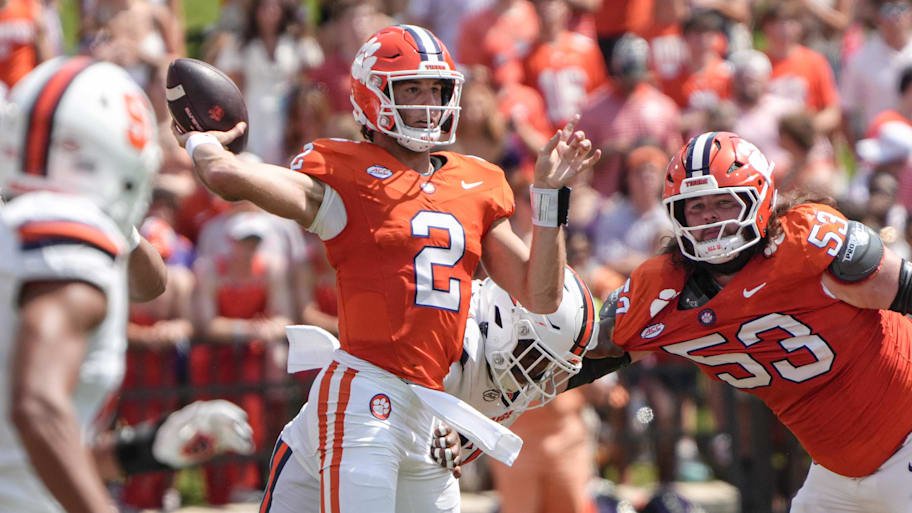
Cade Klubnik, Clemson QB
This was supposed to be the year that Clemson reinserted itself into the national championship conversation. After a few down seasons—at least, by the lofty standards set by Dabo Swinney's impressive program of the 2010s—the Tigers returned the core of a team that clawed its way to a surprising ACC championship and CFP berth a year ago and played a competitive game against Texas. At the center of it all was quarterback Cade Klubnik, who put together his best season, tossing for 3,639 yards with 36 touchdowns and just six interceptions in 2024.
Klubnik entered this season near the top of the Heisman conversation, but opened the year extremely flat, especially in losses to LSU and Georgia Tech. His completion percentage and yards per attempt numbers have recovered a bit in recent wins against overmatched North Carolina and Boston College teams, but his touchdown rate is way down from 2024, his interception rate has more than doubled and he’s really only used his legs to great effect in two games: Georgia Tech and BC.
Clemson is 3–3 and almost certainly out of the CFP race, and while Klubnik is far from the only issue for Swinney's team, he hasn’t elevated the Tigers the way one would hope from a top-flight college quarterback.
DJ Lagway, Florida QB
DJ Lagway’s anticipated sophomore leap was a major justification for Billy Napier keeping his job in 2025. The Gators took a step forward late in the year, with Lagway showing off his truly prodigious arm talent. Lagway dealt with injuries throughout the offseason, and while he’s completing a higher rate of passes this season, his touchdown rate has dropped, he’s still throwing too many interceptions (with his five picks costing Florida a chance to upset LSU) and his average yards per attempt has tanked from 10 in 2024 to a middling 6.6 in ’25.
Lagway has really struggled throwing the deep ball, something that should set him apart, completing just six of 19 throws over 20 yards with one touchdown and four interceptions, per Pro Football Focus.
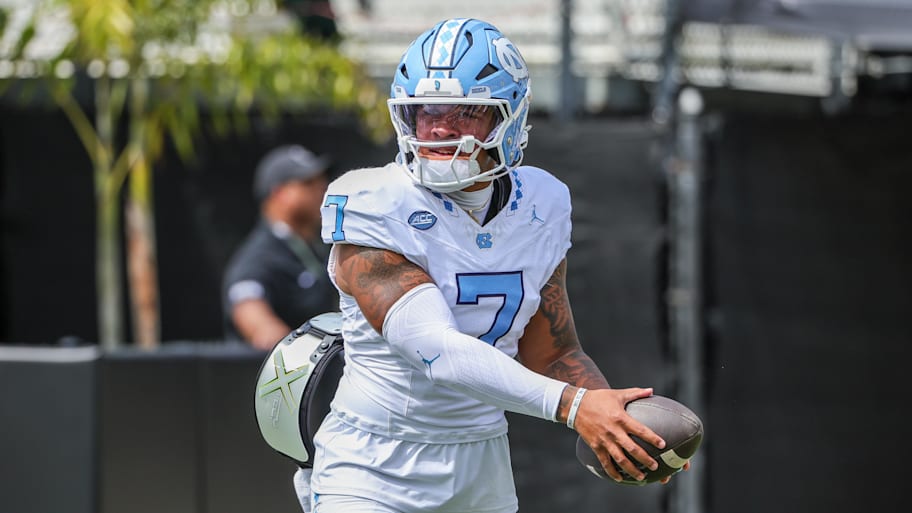
Gio Lopez, North Carolina QB
The failures of UNC coach Bill Belichick and general manager Mike Lombardi to effectively built out a roster via the transfer portal has turned into one of the biggest stories of college football’s first half. The Tar Heels are 2–3 and have been completely noncompetitive against its power conference opponents this year, losing those games by an average score of 40–11.
The struggles of quarterback Gio Lopez highlight just how bad things are in Chapel Hill. Lopez, a solid starting quarterback for South Alabama last year, has traded the job with Max Johnson, who has been a bit safer with the ball but less explosive, though neither player has been effective. It is not immediately clear whether or not this was an evaluation miss—something that has plagued the roster, as evidenced by a Group of 5 coach telling The Athletic’s Bruce Feldman that he couldn’t believe the Tar Heels kept targeting the same players in the transfer portal as his small school. The offensive staff helmed by Freddie Kitchens could also be misusing Lopez, who threw for 2,559 yards and 18 touchdowns a year ago while providing a threat on the ground. Either way, Lopez’s poor play is indicative of how North Carolina’s season has collapsed.
Arch Manning, Texas QB
Let’s get this one out of the way. No, Arch Manning is not college football’s “first flop”—by any stretch. And after last week’s win over Oklahoma, during which Manning executed within the game plan while making some big-time throws in key moments, things appear to be on the upswing. It is not Manning’s fault that he entered the year as the Heisman Trophy favorite and with an immense amount of hype for a player after just a few starts over lesser competition under his belt. Even so, he has played well below even reasonable expectations for a player with his pedigree.
Manning played well against Group of 5 foes San José State and Sam Houston, but struggled mightily in the season opener at Ohio State and, bizarrely, against UTEP. He was not the team’s biggest problem in its loss to Florida, but didn’t do much to help the Longhorns challenge a Gators team that has had its back against the wall all year. The win over the Sooners is a meaningful step forward, especially given the challenge that Brent Venables’s defense presents, but Manning has to use it as a jumping off point for the second half.
Garrett Nussmeier, LSU QB
Along with Manning and Klubnik, LSU’s Garrett Nussmeier is another preseason Heisman favorite whose season hasn’t gotten off to the start many had hoped. Nagging injuries may be a factor for Nussmeier, though coach Brian Kelly has downplayed the impact on his play.
Last year, Nussmeier was a definitional gunslinger, eclipsing 4,000 yards while tossing for 29 touchdowns and 12 interceptions. His yards per attempt and touchdown rate is down this season, while he’s throwing picks at a higher rate. The entire Tigers offense has been sluggish along with him. After finishing 2024 rated 11th in offensive SP+ by ESPN, the Tigers are 45th in the metric this year, and haven’t scored more than 20 points against a Power 4 opponent.
Jehiem Oatis, Colorado DL
Back in 2022, Jehiem Oatis looked like he might be the next great interior defensive lineman for Nick Saban’s Alabama program. As a true freshman then, he recorded 29 total tackles with a sack and a pair of tackles for loss for the Crimson Tide, and graded out quite well at PFF, with a 75.4 grade for the season. He continued to play a big role under Saban in ’23, but played in just four games under DeBoer in ’24, preserving a year of eligibility. He ultimately transferred out of Tuscaloosa, telling On3 “the new staff wasn’t for me.”
He landed at Colorado with high expectations, after being ranked No. 7 among defensive linemen in the transfer portal by 247Sports. Through the first half of his debut season with the Buffaloes, the production just hasn’t been there. Oatis is credited with just five combined tackles and has broken up a pass. Per PFF, he’s played just 94 snaps on the season, and has been credited with just one pressure, in Week 5 against BYU. Things are trending in the wrong direction as well, as Oatis played just five snaps in Colorado’s Week 7 win over Iowa State.
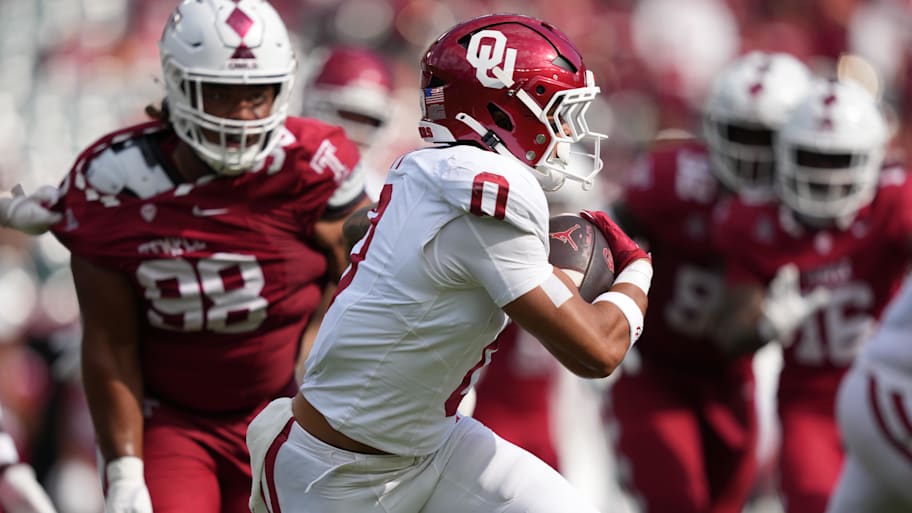
Jaydn Ott, Oklahoma RB
Ott was a major bright spot for a struggling Cal program in 2023, rushing for 1,315 yards and 12 touchdowns en route to first-team All-Pac-12 honors. He opted against transferring, returning to the Golden Bears in ’24, but he was hampered by an ankle injury, playing in 10 games but managing just 385 yards and four scores on 116 carries—less than half of his workload from the season before.
After transferring to Oklahoma for the 2025 season, Ott dealt with a shoulder injury in the offseason that slowed his ramp up for Week 1. He has played in all but one game for the Sooners however, but his impact has been minor and his playing time has varied. After playing 22 snaps against Michigan, he was in on just six the following week against Temple. After missing the Auburn game, followed by a bye, he played a season-high 29 snaps against Kent State, but was in on just four plays in the loss to Texas. On one of those plays, he dropped a well-blocked screen pass. On another, he failed to throw a block on a carry for wide receiver Deion Burks. His only carry went for two yards.
Oklahoma has struggled on the ground as a team, rushing for just 32 yards against Auburn and 48 against Texas. Quarterback John Mateer has been the team’s biggest threat on the ground, while Tory Blaylock leads the team with 290 yards. Ott has been a dynamic playmaker in the past, it just hasn’t yet translated to his time in Norman.
Ryan Williams, Alabama WR
Ryan Williams exploded onto the scene as a freshman in 2024, helping DeBoer and Alabama beat Georgia with one of the most incredible touchdowns of the season. He finished the year with an impressive stat line for any freshman, catching 48 passes for 865 yards and eight touchdowns. He hit the offseason as one of the biggest names in the sport, sharing the cover of EA Sports College Football 26 with another spectacular young receiver, Ohio State’s Jeremiah Smith. Williams has had strong performances as a sophomore, but hasn’t been the consistent force that was expected after his debut campaign.
Williams had a rough outing in the season-opening loss to Florida State, putting up 30 yards on five receptions while dropping three passes. He left the game with a concussion, which cost him Alabama’s Week 2 game against Louisiana-Monroe. He returned with a vengeance against Wisconsin in Week 3, going off for 165 yards and two catches on five receptions, and he had another solid game against Vanderbilt (6/98/1), but was quiet against Georgia and went without a catch against Missouri, hampered by an injury despite being listed as probable ahead of the game and playing 30 snaps. He was targeted once in the game.
Williams has six drops on the season, and a drop rate of over 22% per PFF, almost double that number from last year. Alabama’s passing offense hasn’t suffered much despite his up-and-down production, with Germie Bernard stepping up as Ty Simpson’s top target. Even so, Williams is a gamebreaking talent and Alabama won’t be at its best until it has a healthy and more consistent Williams on the outside.
More College Football on Sports Illustrated
Listen to SI’s new college sports podcast, Others Receiving Votes, below or on Apple and Spotify. Watch the show on SI’s YouTube channel.
This article was originally published on www.si.com as College Football’s 12 Most Disappointing Players at Halfway Point of 2025 Season.
